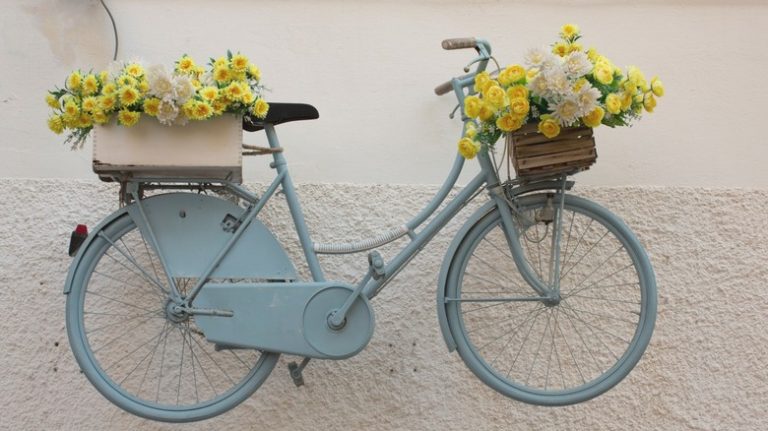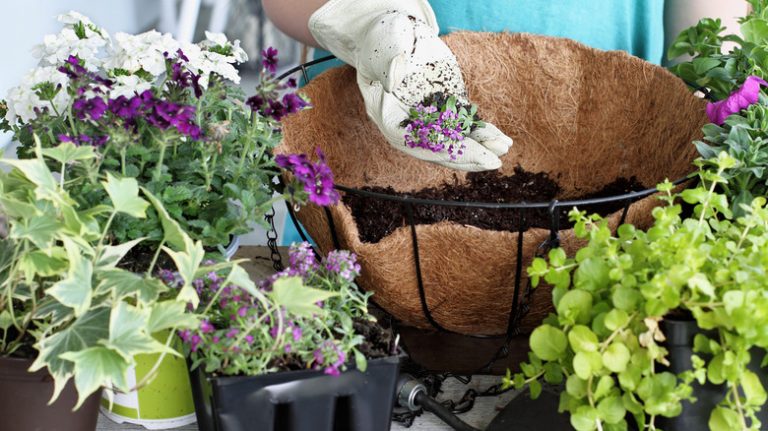Perennial lavender plants go through many metamorphoses during their lifetime. The most notable is the annual coming out of dormancy in the spring. A mere bundle of woody sticks and silvery green leaves, the dormant herb bounces back to life as the temperatures rise. But that’s not always a given. Sometimes the winter inertia becomes permanent. Other times, the plant goes from peak health to wilting and dying in front of your eyes in even ideal weather conditions. And, it might stay that way unless you intervene to revive it.
Before bringing the perishing lavender back to life, you have to know what’s killing it. Maybe it’s the water, the soil, the sun or lack thereof, or the temperature and humidity in the air. Pests and diseases claim responsibility for many deceased plants, as does transplant shock and lack of pruning. But, if you act in time, you could save the aromatic herb and nurse it back to sound health.
Fix watering quantity and patterns
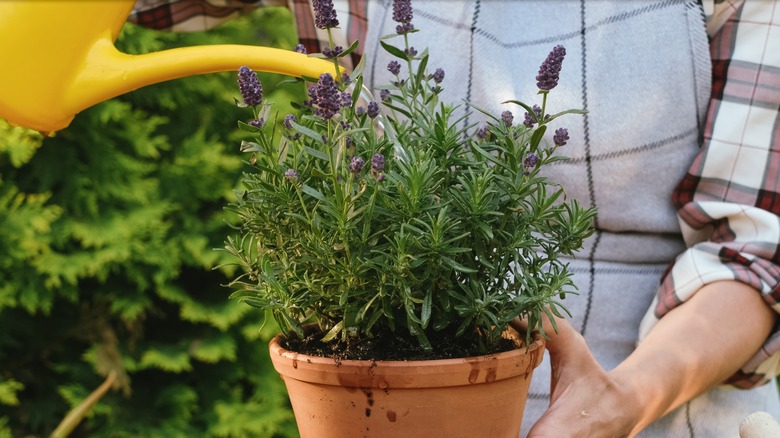
Lavender’s love for water is a little complicated. The seedlings need steady levels of moisture in the soil, but established plants prefer irrigation after long intervals. Because of these hydrating extremes, the herb is subject to dying from too much or too little water. In too-dry conditions, the leaves droop and lose their lush green luster. The plant goes into self-preservation mode, conserving its energy for the necessities to keep it alive. But over-watering is just as lethal. First, the leaves turn yellow before going brown. Then the drooping herbs emit a rotting smell, possibly attracting pests, and growth stops.
To revive a lavender wilting from watering complications, check the soil. Young plants will need about a gallon’s worth of hydration, between rain and watering, per week. However, once mature they only need irrigating twice a month. For herbs suffering from over-watering, hold off hydration to allow the growing medium to dry. Dig up the plants and trim off rotten roots and diseased and damaged stems and leaves. Before repotting or transplanting into fresh soil, treat with a fungicide.
Amend the soil texture, pH, and nutrient balance
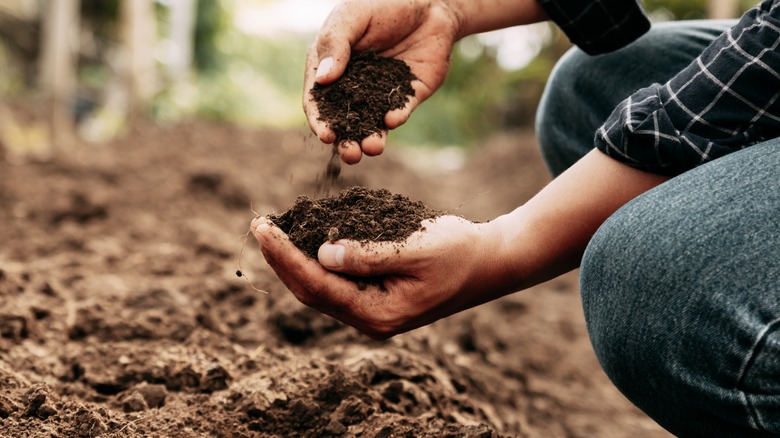
The soil’s type, texture, and acidity are all important factors that can make or break your lavender’s health. Compact and clayish ground hinders the growth of the root system and is often water-logged. Clay also tends to have low pH levels, which implies high acidity. This contrasts with the more alkaline Mediterranean terrain, the herb’s native habitat. Getting the soil wrong can cause yellow leaves, stunted growth, wilting, and death.
Many varieties of the herb flourish in a sandy medium that drains well and is more neutral to alkaline. Clay sediment can be amended with coarse sand to improve its texture, drainage, and oxygen concentration. Before planting the seedlings, test the pH and make sure it’s between 6.5 and 7.5. To raise the pH, you can add limestone to the soil and test it again after a week or two. Sulfur will treat high-alkaline soil, but it’s best to limit its application to 2 pounds per 100 square feet once a year. To feed lavender, use compost and organic fertilizer and supplement with zinc, boron, and magnesium.
Look for and eliminate pests
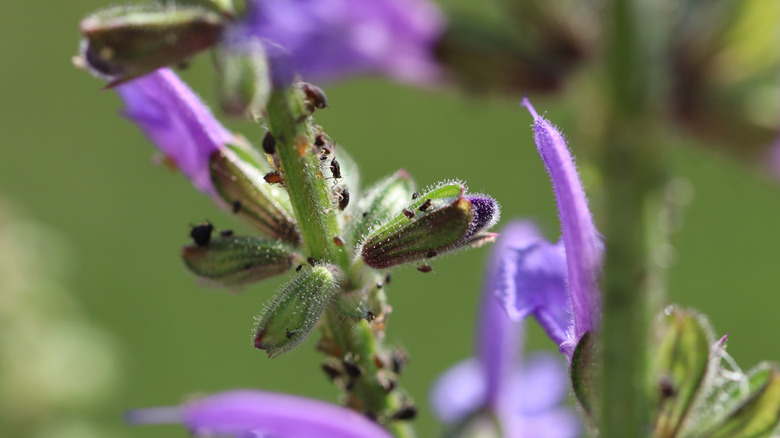
sunday pictures/Shutterstock
Pests of different species and eating habits take an interest in lavender. Rodents like moles burrow under the plants, accidentally uprooting them, while voles devour the roots. Above ground, infestations of aphids, whiteflies, spittlebugs, or four-lined plant bugs can be devastating to the herbs. Aphids are tiny critters that cause yellowed leaves, twisted shoots, and stunted growth. Their cousins, whiteflies, suck the sap from the leaves, killing them in the process. Often mistaken for beetles, the bright red four-lined plant bugs cause wilting of young shoots.
Eliminating the pests helps the struggling herbs. To get rid of moles and voles, use traps to capture and release them far from your property. Aphids can be washed right off your lavender leaves with a garden hose. The same high-pressure water treatment works against the nymphs of four-lined plant bugs to manage their numbers. To combat whiteflies, you can use sticky traps and reflective mulch near your plants.
Treat underlying diseases
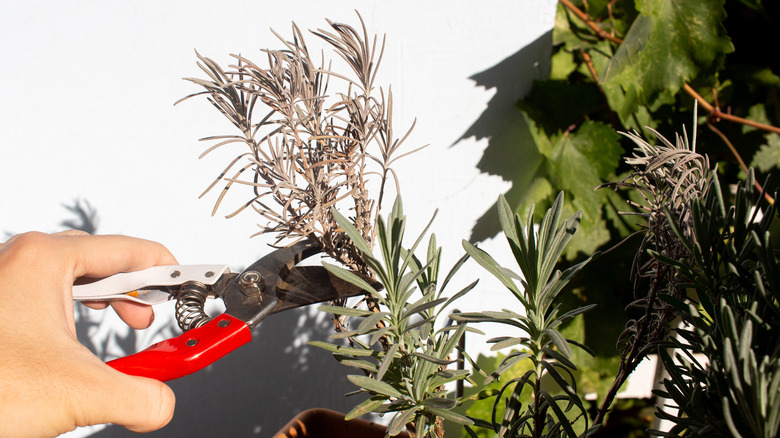
Aybarskr/Shutterstock
Lavender is susceptible to very few diseases, but many of them are fatal. Shab is a fungal infection transmitted by the wind and causes black spots and wilting of young shoots. Xylella is another deadly disease that’s caused by bacteria spread by sap-sucking bugs. The bacteria multiply inside the plant tissue, destroying the herb from inside. A third disease is triggered by alfalfa mosaic virus, which aphids carry around. The leaves become discolored, deformed, and eventually die. However, the most common lavender disease is root rot. A pathogen in the soil causes severe damage to the root system.
Both Shab and Xylella diseases have no cure. To prevent their spread to healthy herbs, pull out and destroy the infected ones. Meanwhile, the only way to fight off the alfalfa mosaic virus is to get rid of aphids. However, root rot, if detected on time, is fairly easy to recover from. Dig out the plants and cut off the rotten roots. Repotting the potted plants in healthy soil and transplanting garden herbs to uncontaminated areas will help them recover.
Provide enough sunlight
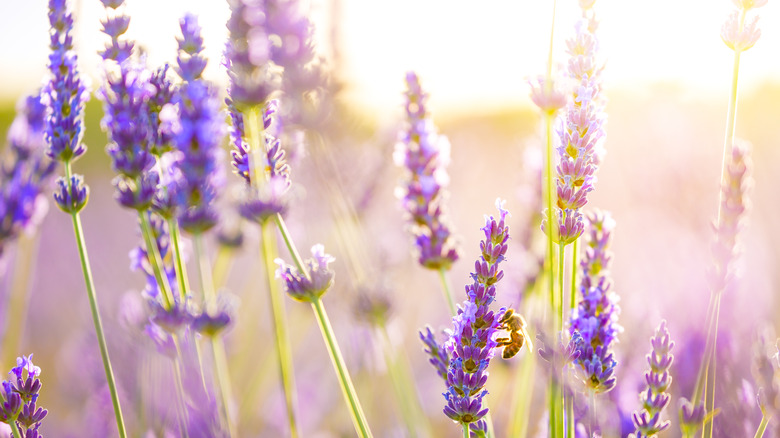
Spooh/Getty Images
In the Mediterranean basin and India, where lavender grows in the wild, the sun shines bright most of the year. The herb needs this sunlight to generate enough energy to develop dense foliage, produce flowers, and stay in optimal health. However, the plant’s silvery-green leaves don’t have enough chloroplasts to perform photosynthesis in dim light. As a result, it’s susceptible to light-deficiency complications such as stunted growth, legginess, and fewer flowers. With continued sun deprivation, the leaves turn yellow and drop, making the plant prone to diseases.
Lavender needs between 6 and 8 hours of sunlight every day during the spring and summer. To revive an herb growing in the shade of another plant, transplant it to a sunny spot. For indoor growing, move the pots to a south-facing window to benefit from longer light hours. In the absence of enough sunlight, artificial light like a grow bulb is a suitable alternative.
Adjust the temperature and humidity levels
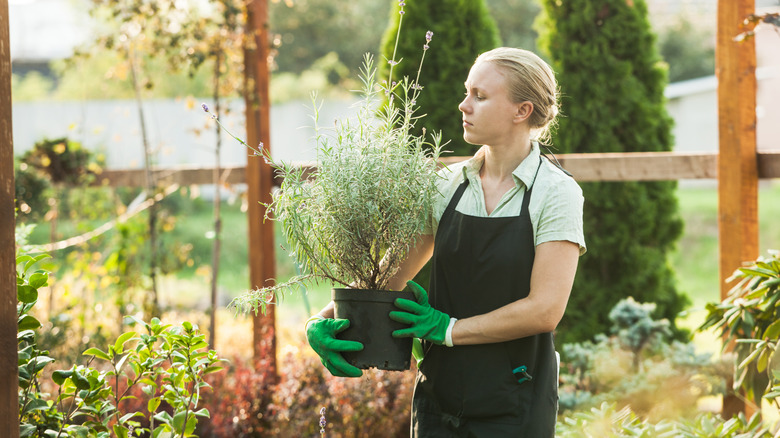
Oksana Shufrych/Shutterstock
Non-native plants don’t often adapt well to the weather conditions in their new home. Lavender is no exception. Changes to the temperature and humidity can have a drastic impact on the herb’s health. A warm-weather plant, it struggles with freezing temperatures. Sustained exposure to cold weather leads to a lack of flowering while the dormant plant could freeze in harsh winters. To help the potted plant, bring it indoors when the temperatures drop. For hardy varieties kept outdoors, mulching with gravel or straw can help protect them against freezing.
Humidity is another factor to consider when the lavender is dying. Accustomed to dry weather, many varieties can’t grow well in high humidity levels. Increased air moisture has the same effect as over-watering the herb. Fungal infections and wilting are common symptoms. To bring the houseplant back to health, move it away from other plants. A fan placed nearby or a dehumidifier can manage the humid conditions. Herbs outdoors benefit from improved soil ventilation and drip irrigation to decrease moisture levels.
Revive the dying plant in the winter
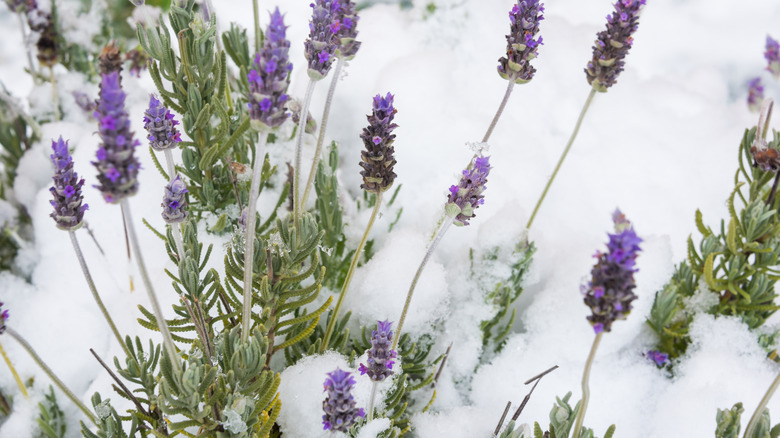
Mariauspenskaya/Getty Images
Harsh winters aren’t merciful to lavender. Even though the plant is dormant at the time, adverse conditions can threaten its very survival. Some factors like lack of pruning, or excessive pruning, can make it more vulnerable to inclement weather. Between the cold temperatures and constantly damp soil, the herb’s crown turns gray and the stems woody. For all appearances, it looks lifeless and, unless sheltered from the elements, it might not come back to life.
To test for life signs in the woody crown, snap off one of the stems. If the stalk is green and doesn’t break easily, and the leaves are fragrant, you could nurture it to health. To revive a lavender on its last leg, transplant it into a pot and bring it indoors. With the light, temperature, and humidity set at optimal levels, water it enough to keep the soil slightly moist. Then, in the spring, it will show the first signs of growth.
Repot potted lavender
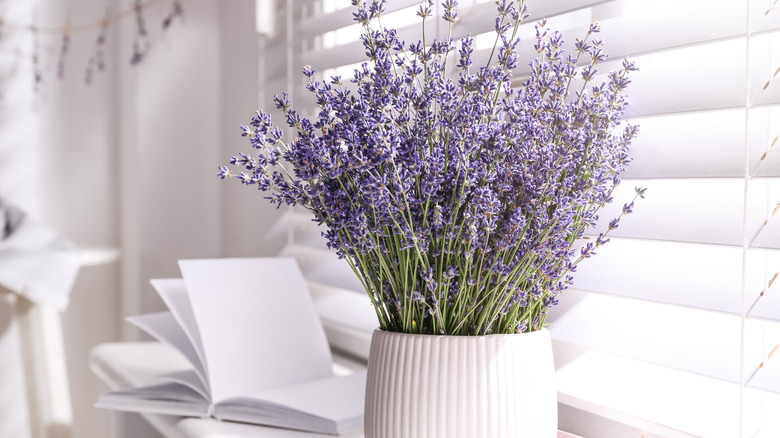
New Africa/Shutterstock
A potted lavender plant growing in ideal conditions has a robust root system with a fast growth rate. When the plant shows signs of poor health, it could be root-bound. When this occurs, the cramped herb has stunted growth and the soil dries quickly while the leaves and stems have browning at the tips. But when the roots poke out of the drainage holes in the pot, that’s a dead giveaway. Digging in the soil will likely reveal the roots circling within the container and taking up every inch of space. Transplanting is the best option to revive the root-bound plant.
Even if the lavender isn’t root-bound, repotting is also the best solution for root rot, fertilizer residue, and pathogen-contaminated soil. Transplanting any outdoor herbs to a new pot should be done in the spring unless diseases are threatening its life. A container an inch or two larger than the current one with drainage holes at the bottom is the ideal vessel. After repotting, spread organic compost on the soil and water to help the roots settle.
Prune woody growths in moderation
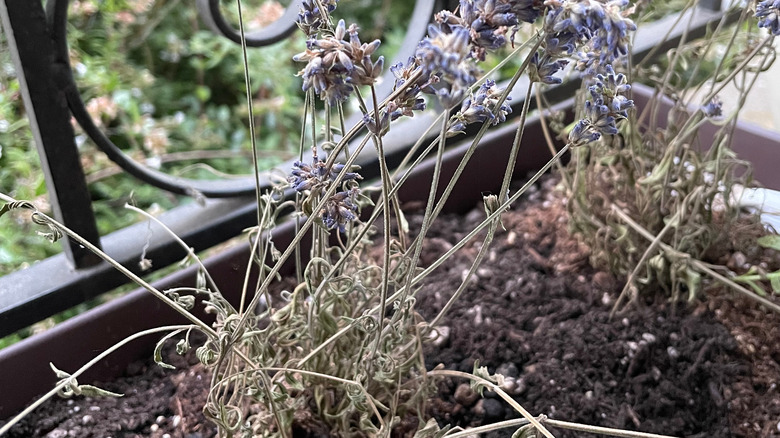
Lolisen/Shutterstock
Lavender is a woody plant; there’s no getting around that. After the herb is established, the base of the crown takes the form of a slender tree trunk. Apart from the aesthetical concerns with the transformation, fresh shoots may fail to come out of the stump-like formation. And once the whole crown has turned into a solid piece of wood, there’s no reviving the herb. This is why cutting too aggressively is one of the biggest mistakes to avoid when pruning lavender.
Depending on how advanced the woodiness has progressed, there are two ways to infuse new life into the lavender. For a shrub with more silvery-green foliage than a brown base, long-term and moderate pruning is recommended. Divide the stems into sections and cut one area down to the trunk each year. This allows the plant to grow back one section at a time. However, this takes many years and isn’t always successful. The other option is to start a new herb from the dying one with layering. Selecting a woody stem, remove the leaves and bark at the top. Dip it in growth hormone, bend it down, and plant the tip in the soil. When roots develop, cut it from the base and transplant it to a permanent location.
Nurse a plant suffering from transplant shock
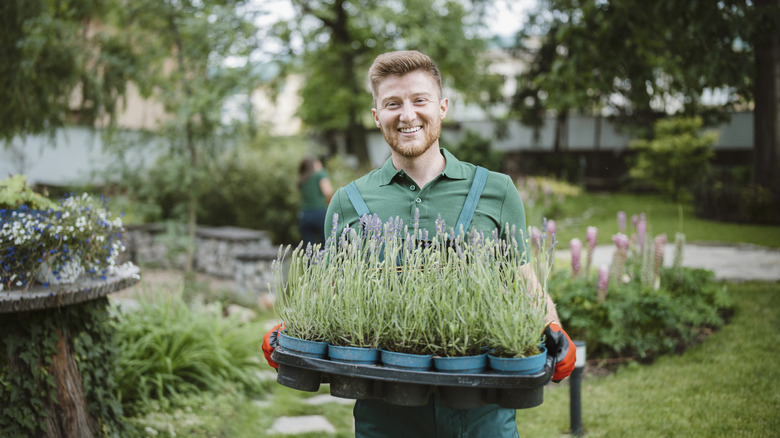
Artistgndphotography/Getty Images
Transplant shock is par for the course for perennial plants, both potted and those growing outdoors. Lavender is a slow adapter and changes in the soil and location can further complicate the transplant aftermath. Following replanting, the herb might wilt and show signs of giving up on life. If done in early spring or fall and in the right soil, the perennial has the best chance of getting over the shock quickly. But transplanting errors could aggravate the wilting and threaten its life. Forgetting to water it and using fertilizers are easy mistakes to recover from. However, moving the herb either in the summer or winter could be fatal.
To save the herb and ease it into the new environment, water it well immediately after replanting. The root system settles and absorbs nutrients better in a moist medium. Then, allow the topsoil to dry before the next watering. If you have used fertilizer, replant the herb in fresh soil and sprinkle it with a little organic compost instead. For potted seedlings moved outdoors, hardening them off to the conditions in the garden can revive them. Placing them back indoors, take them out for an hour or two every day, and increase their conditioning over a couple of weeks.
Rejuvenate leggy lavender
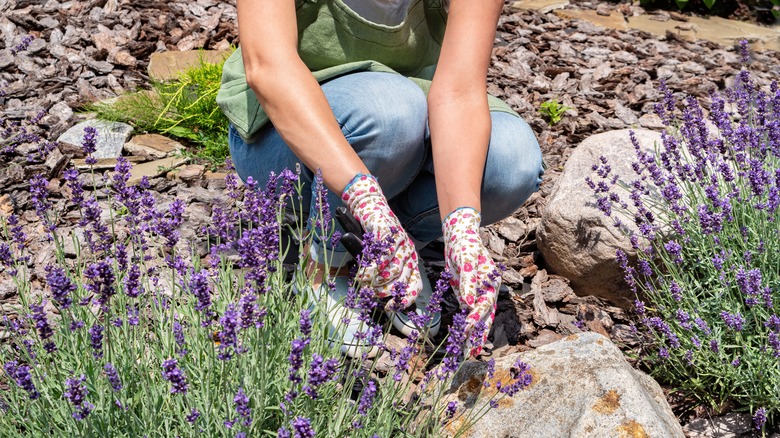
nieriss/Shutterstock
Unlike woody growths, which are a natural process, a leggy lavender plant is the product of inadequate feeding and neglect. When the stems have few leaves near the tip and the flowers are small, the misshapen plant has a leggy problem. With its almost barren and woody stems, the plant may be struggling with little sunlight. New leaves stop growing, signaling a quickening aging process. The straggly appearance can also reflect a lack of, or untimely, pruning. It might not be dying yet, but legginess is a gateway to woodiness, which can mean the end of the lush aromatic plant.
To rejuvenate the lavender, have the soil tested for excessive amounts of nitrogen. Repotting or transplanting to sandy soil with better drainage could solve the problem. Another fix is to check that the herb is getting enough sunlight. Regular pruning is also key to knocking the unkempt herb into shape. Early in the spring, trim off dead stems, avoiding the woody base, to encourage uniform new growth.
Plant a variety suitable for your microclimate
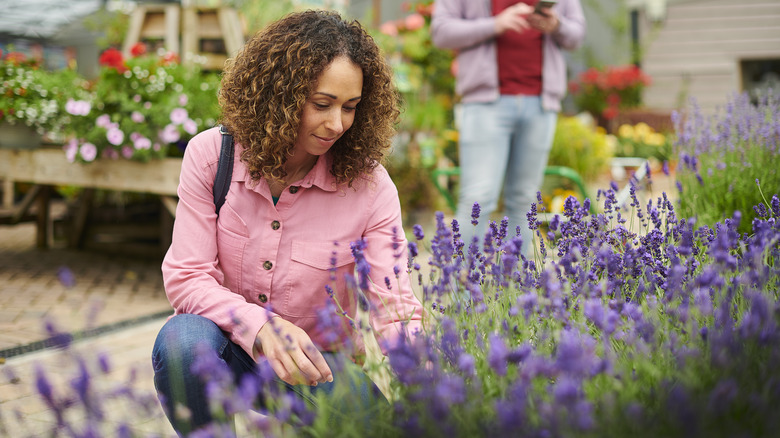
Sturti/Getty Images
When no matter what you do, the lavender still struggles, you might have planted the wrong variety. There’s nothing you can do but avoid the same fate for future herbs by selecting ones more suitable for your microclimate. The various species of the plant spread across USDA hardiness zones 5 to 9. They cover cold, hot humid, and hot and dry climates. The local nursery is a better source for lavender seeds and seedlings specific to your area than buying online.
For cold zones in the Northeast and Upper Midwest, varieties of English lavender are outstanding candidates. They include Munstead, Jean Davis, Hidecote, and Vera, among others. In hot and humid climates like the Mid-Atlantic, and the South, French, Spanish, and Sweet Lavender do best. California and the Southwest have hot and dry climates making Goodwin Creek Lavender and Otto Quast Spanish Lavender great choices.


